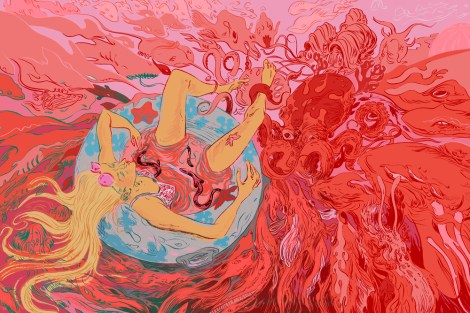You’ve heard the term “ocean acidification,” and I know what you’ve been thinking: “It can’t be as bad as they say. I remember the ’90s. I made it to a few Phish shows. I’ve seen what goes on in the parking lots, and there’s nothing wrong with a little ‘acidification.’ So the Ocean drops out of Brown for a semester and stares at its belly button. The Ocean’s belly button has the Great Barrier Reef in it. The Ocean will enjoy that.”
But there is a lot more at stake than the Ocean dropping out of school to make burritos and follow a jam band. Ocean acidification is known as “climate change’s evil twin,” and considering what a swell fella climate change is, this should give you an idea of just how dangerous ocean acidification may be.
And the twin metaphor is an apt one: Climate change and acidification work together and both have the same anthropogenic mamma: carbon dioxide.
Here’s how it works: Since the beginning of the industrial revolution, we’ve been cranking out carbon dioxide, or CO2, at an ungodly rate, and as the atmosphere floods with the stuff, the oceans naturally strive to soak some of it up. The process, called air-sea gas exchange, is affected by temperature, wind, waves, weather, and plants and animals in the ocean, but basically when you have a buildup of CO2, or any other gas, in the atmosphere, it will seep into the water below until the water reaches chemical equilibrium with the air.
The oceans absorb over a quarter of the CO2 we produce — about 22 million tons of CO2 a day [PDF]. Estimates put the damage so far at 530 billion tons of human-produced CO2 sucked into the seas since the dawn of the industrial revolution. Of course, I already know what you’re going to say. “Awesome!” says you. “That’s a quarter of my CO2 I don’t even have to worry about! I’ll take the long way home from Stucky’s.”
Well not so fast, Charlie! Just ’cause it’s out of sight, doesn’t mean it should be out of mind. Over the last 200 years, human pollution has caused the oceans’ pH to drop 100 times faster than it did in the previous 650,000 years. To give you an idea what the oceans are going through, try to imagine taking in the entire six seasons of The Wire in 32.4 seconds. You’d have 11 strokes. And that’s just the tip of the iceberg (a cliché that will baffle your grandkids). If CO2 emissions continue on their current trajectory, we could see a further drop in pH four times worse than what we’ve seen so far by the end of the century. If projections hold, we’re headed toward an ocean unlike any seen for 25 million years!
What does it all mean? When CO2 mixes with seawater, it creates carbonic acid, and, spoiler alert, increasing acid in the oceans makes the oceans more acidic. The fossil record shows that even a slight change in the ocean’s acidity can cause massive die-offs. When CO2 builds up in an organism it causes a condition know as acidosis. Acidosis hurts the immune systems of fish and other marine organisms, causing stunted growth, reproductive failure, respiratory problems, and even death [PDF]. Throw these massive problems on top of ecosystems already stretched to the breaking point by overfishing, and the effects on not only biodiversity, but the world’s food supplies, could be calamitous: The oceans are the primary food source for 3.5 billion people.
And that’s not all. Corals and shellfish use an ion in the water called carbonate to build their shells and skeletons. As a result of ocean acidification, half of the oceans’ useable carbonate could be gone by the end of the century. Sure, we could make billions of tiny barrels and sink them into the briny deep along with tiny suspenders so the lobsters won’t have to go nude, but that’s a stopgap at best. And what about the oysters, snails, mussels, and shrimp — animals that would look ridiculous in tiny barrels? Their shells are thinner and more brittle, they’re not growing as big, or they’re not growing at all. Some corals are incapable of building their skeletons, and reefs are crumbling. By 2050, we may reach a tipping point where reefs can’t keep up with the rate of loss.
While some climate change models predict some fisheries will be winners in our warmer future, ocean acidification could turn that notion upside down. When you add ocean acidification to climate change models, a projected 30 percent growth in North Atlantic fisheries productivity turns into a 15 percent decline. Predictions for other areas, like the tropics, go from bleak to horrifying.
And this is where it all comes back to you. As climate change turns fertile land into arid wastes and rising tides cost us even more, ocean ecosystems will be an increasingly important part of our global food bank. The good news is, actions that would reduce greenhouse gas emissions will pay dividends with ocean acidification as well. The problem is, we haven’t exactly been making great strides there, and damage that has already been done will continue to affect the rising acidity in the oceans: The sea’s absorption of CO2 is a long, slow process, and the oceans will continue to soak up what we’ve already dumped into the air until an estimated 80 percent of all human-produced CO2 is locked up in the great blue.
We dump so much into the ocean — stupid love letters stuffed in bottles, Corona-thinned pee, and most cruelly of all, secondhand Jimmy Buffet — and the ocean takes it. (I think the ocean is a bit of a hippie. That’s why it doesn’t have a real job, spends so much time at the beach, and keeps taking my frisbees.) But the billions of tons of CO2 we choke it with may finally be too much. If you can’t see that, you’re tripping on the brown acid.



